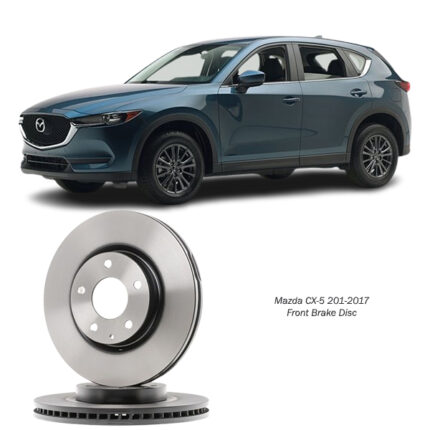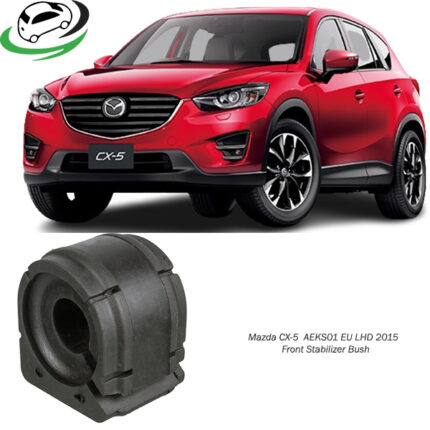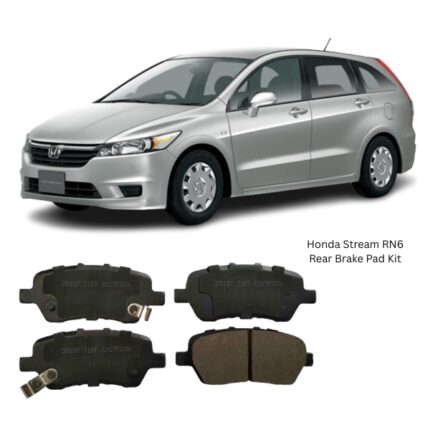Get Honda Stream RN6-RN9 Rear Brake Pad Kit D5137 in Kenya
The Rear Brake Pad Kit is an essential component of a vehicle’s disc braking system, specifically engineered to provide reliable braking performance, enhanced safety, and reduced wear across the rear axle. While front brakes typically perform the majority of braking in most vehicles, the rear brake pads play a critical balancing role—ensuring even deceleration, stability under load, and effective emergency braking response.
A complete rear brake pad kit offers more than just replacement pads; it delivers a full solution to restore optimal braking efficiency, reduce noise, and extend the lifespan of associated components such as rotors and calipers. Whether used for routine maintenance or full-system restoration, high-quality rear brake pads contribute to confident stopping and long-term vehicle safety.
Construction and Components
The Rear Brake Pad Kit includes several carefully designed parts that function together as part of the rear braking system. A typical kit includes:
-
Friction Pads: These consist of a metal backing plate bonded to a friction material layer. The pads press against the brake rotor to create the friction necessary for slowing down the vehicle.
-
Shims: Multi-layered or rubber-coated shims are often attached to the back of each pad to absorb vibration and reduce brake noise.
-
Wear Indicators: Either mechanical or electronic sensors designed to alert the driver when the pad material has reached minimum thickness.
-
Abutment Clips and Springs: Hardware that ensures correct positioning and movement of the pads within the caliper, preventing rattle and uneven wear.
-
Grease or Anti-Seize Compound (included in some kits): Helps to lubricate contact points and caliper guide pins, ensuring smooth operation and minimizing squeal.
Each component in the kit is manufactured to meet or exceed OEM specifications, ensuring consistent performance and durability across diverse driving environments.
Friction Material Types
The friction layer is the heart of every brake pad and is engineered to handle extreme heat, pressure, and wear. Rear brake pads are commonly made from one of the following materials:
-
Ceramic: Known for producing minimal brake dust, running quietly, and lasting longer. Ideal for everyday road use and light-duty conditions.
-
Semi-Metallic: A blend of metals and synthetic materials that offers high heat resistance and excellent stopping power. Often used in performance or heavy-duty settings.
-
Low-Metallic NAO (Non-Asbestos Organic): Contains organic fibers with a small amount of metal. Offers quiet operation and good braking feel with moderate dust production.
The selection of material affects braking performance, rotor wear, noise levels, and heat dissipation.
Function Within the Braking System
The Rear Brake Pad Kit serves multiple important functions as part of the disc brake system:
-
Assist Front Brakes in Deceleration: While front brakes handle more braking load, rear pads stabilize the vehicle and provide balanced braking force.
-
Support Emergency Braking: In sudden stop scenarios, rear brake pads play a vital role in distributing the load and preventing rear-end instability.
-
Engage with Parking Brake Systems: Many vehicles integrate the rear pads with mechanical or electronic parking brake systems to hold the vehicle stationary.
-
Enhance Vehicle Balance: Proper rear brake pad operation prevents excessive front-end dive and supports controlled deceleration.
Overall, rear pads are key to achieving smooth and safe braking under all driving conditions.
Benefits of Using a Quality Rear Brake Pad Kit
Using a premium rear brake pad kit provides several advantages, both immediate and long-term:
-
Consistent Braking Performance: Quality pads offer predictable friction characteristics and pressure modulation.
-
Improved Driving Safety: Reliable braking power from the rear enhances overall vehicle control, especially during abrupt stops.
-
Reduced Brake Noise: Advanced shim technology and anti-rattle hardware minimize vibrations and squealing.
-
Longer Component Life: Properly matched pad materials and hardware reduce wear on rotors and calipers.
-
Clean Operation: Ceramic and low-dust pads help maintain wheel cleanliness and reduce the need for frequent washing.
-
Easy Installation: Complete kits include all necessary hardware, ensuring a faster, more professional installation.
By restoring full braking functionality, a rear brake pad kit contributes directly to ride quality, peace of mind, and vehicle safety.
Common Signs of Worn Rear Brake Pads
Rear brake pads should be regularly inspected and replaced when necessary. Common symptoms of wear include:
-
Squealing or Squeaking: Usually caused by wear indicators contacting the rotor surface.
-
Grinding Noise: A metal-on-metal sound typically indicates that the pad’s friction material has completely worn away.
-
Brake Warning Light: On vehicles with electronic wear sensors, this illuminates when pad thickness is low.
-
Increased Stopping Distance: Reduced friction material affects braking efficiency, especially under load.
-
Visible Thin Pads: Pads measuring less than 3 mm in thickness should be replaced immediately.
-
Uneven Pad Wear: Could indicate sticking calipers or improper pad installation.
Timely replacement prevents damage to rotors, improves safety, and maintains optimal system performance.
Installation Guidelines
The installation of a Rear Brake Pad Kit requires basic mechanical tools and attention to detail. The general process includes:
-
Raise the Vehicle and Remove Wheels: Use proper safety procedures to access the rear brake components.
-
Remove Caliper Assembly: Loosen bolts and suspend the caliper without placing strain on the brake hose.
-
Remove Old Pads and Hardware: Slide out the worn pads and inspect for signs of uneven wear or damage.
-
Clean the Caliper Bracket and Hardware Contact Points: Use a wire brush to remove rust or buildup.
-
Install New Hardware: Replace anti-rattle clips, guides, or shims included in the kit.
-
Lubricate Contact Points: Apply high-temperature brake grease to the back of the pad and caliper slides.
-
Install New Brake Pads: Slide the pads into position and reattach the caliper.
-
Check for Clearance and Free Movement: Ensure the pads are not binding or misaligned.
-
Reinstall the Wheels and Lower the Vehicle: Torque lug nuts to specification.
-
Pump the Brake Pedal: Restore caliper pressure before driving.
A proper bed-in process (gradual heating and cooling through light braking) should be performed after installation to condition the pads and rotors for optimal performance.
Maintenance Tips for Extended Pad Life
-
Avoid Aggressive Braking: Hard stops from high speed increase heat and wear on rear pads.
-
Inspect Regularly: Check pad thickness and rotor surface during oil changes or tire rotations.
-
Flush Brake Fluid: Fresh fluid supports proper caliper function and prevents sticking.
-
Replace Pads in Pairs: Always replace both left and right rear pads together to maintain even braking.
-
Monitor Rotor Condition: Resurface or replace rotors if they are warped, grooved, or below minimum thickness.
Following proper service intervals and driving habits will ensure longer brake life and more consistent performance.
Follow us on Facebook for more parts.




